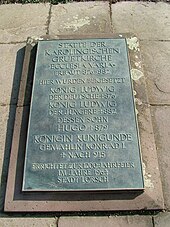Ecclesia varia
The Ecclesia varia ("colorful church") was the crypt chapel of the East Franconian Carolingians in Lorsch . It was part of the imperial Lorsch monastery . The start of construction is given in the Lorsch Codex for the year 876.
Since the Lorsch Monastery was closed in 1564, burned down in 1621 and then used as a quarry for decades, the building had disappeared without a trace over the centuries. Even his position was unsafe. During excavations between 1927 and 1937, Friedrich Behn succeeded in reconstructing the ground plan of a building on the basis of foundation trenches, which adjoined the monastery church to the east and is now generally mistaken for the Ecclesia varia. After that it was a rectangular hall building, in the semicircular east end of which an apse was cut out. Since the foundation walls were almost 4.50 m thick, it is assumed that the chapel had very thick walls. Mortar and plaster finds indicate that it was semicircularly vaulted and provided with deep window niches. It is known that Charles the Bald built a candle foundation for better lighting.
A remnant of the rising masonry of the north wall has been preserved from the building. In 1800 five or nine sarcophagi were excavated in the area of the Ecclesia varia. Only one of them is preserved; it is regarded as the sarcophagus of Ludwig the German († 876). Ludwig the Younger († 882), his son Hugo († 879), Queen Kunigunde († 915) and other Carolingians were also buried in Lorsch .
swell
- On the trail of building history ( Memento from November 3, 2014 in the Internet Archive ), kloster-lorsch.de
- Real Lexicon of Germanic Archeology , Johannes Hoops, de Gruyter, 2001
- denkmalpflege-hessen.de
Coordinates: 49 ° 39 ′ 12.8 " N , 8 ° 34 ′ 14.6" E
